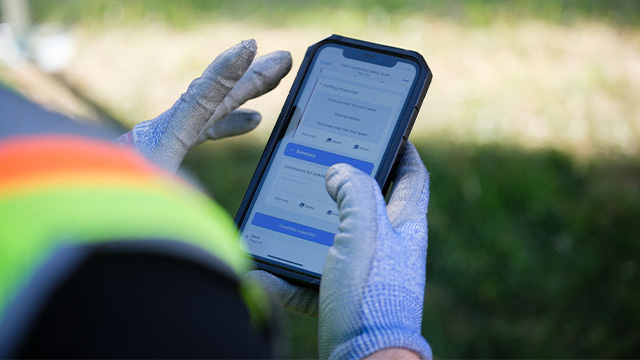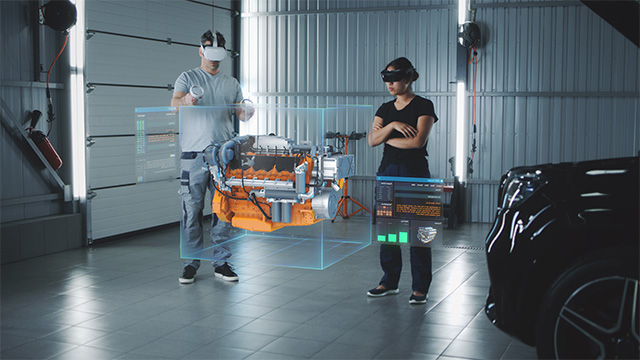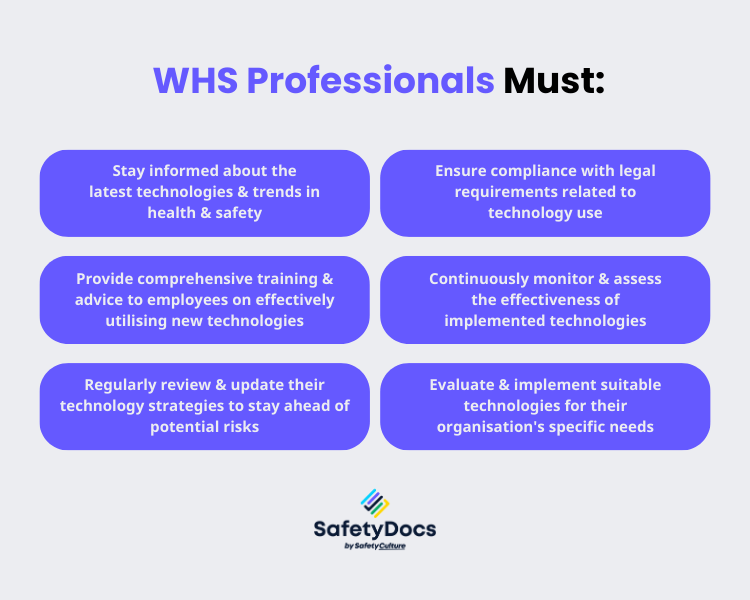Health and safety professionals include various experts, from occupational health and safety representatives, officers, and managers to consultants, coordinators, and advisors. Regardless of their specific role or industry, one thing remains constant: the need for effective tools and technologies to support their work.
Sure, many tools and technologies are available nowadays, but which are indispensable for workplace health and safety? Let's look at nine must-have tools, equipment, and technologies to empower health and safety excellence.
Let's dive in.

Nine Indispensable Tools and Technologies
1. Tools for Risk Assessment
Hazard Identification Software
Before taking any preventive measures, WHS professionals must identify potential workplace hazards. This is where hazard identification software comes into play. Before, this process was done manually and was time-consuming. However, with the rise of digitisation, tools such as interactive checklists, surveys and questionnaires can help identify hazards on time.
Risk Assessment Software
There are several common tools for risk assessment, such as the risk matrix, decision tree, failure modes and effects analysis (FMEA), and the bowtie model. These tools provide valuable insights and help evaluate and manage potential risks effectively. Those are now available in cloud-based workplace platforms such as SafetyCulture, formerly iAuditor.
This workplace management platform helps companies assess, manage, and proactively assess operational risks. It offers features such as risk identification, risk assessment, risk dashboard and analytics, IT risk and cybersecurity management, compliance management, ESG risk management, and an interactive interface with powerful workflows.
2. Communication and Training Tools
Online Training Platforms
Online training platforms offer a flexible and accessible way to educate personnel on safety protocols. It eliminates the necessity for expensive and time-consuming in-person training sessions, offering a more convenient and efficient alternative. Safety personnel can exclusively provide online training, such as refresher courses, to ensure up-to-date knowledge and skills. Using it as a substitute for training, such as learning how to use a fire extinguisher, is not recommended.
Communication Apps for Safety Alerts
Effective communication is crucial in any workplace, which goes double for health and safety professionals. Safety alerts are essential in communicating potential hazards and risks to employees. Communication apps can deliver real-time safety alerts, reminders, and updates to the workforce's mobile devices.
3. Monitoring and Surveillance Safety Technologies
Wearables
Wearable technology can track vital signs, detect environmental changes, and provide immediate emergency alerts. These technologies are beneficial for monitoring workers in high-risk work activities. Examples of wearable technologies that improve workplace safety include:
- Physiological Monitoring Devices: These wearable technologies track workers' vital signs, such as heart rate, blood pressure, and body temperature, to detect fatigue or potential health risks.
- Environmental Monitoring Devices: These devices monitor the work environment for potential hazards, such as toxic gases or loud noises.
- Location Tracking Devices: These devices can track workers' location and movements in emergencies or to ensure their safety during hazardous tasks.
- Exoskeletons and Exosuit Technologies: These technologies support and protect workers during physically demanding tasks, reducing the risk of musculoskeletal injuries.
- Proximity Detection Sensors: These sensors can detect objects or people in the workers' surroundings, preventing collisions and accidents.
Video Monitoring Systems
You can use video monitoring systems to monitor work activities and identify potential occupational safety hazards. These systems can show workplace injuries and also assist in incident investigations by providing visual evidence.
Drones
Drones help businesses reduce risks and improve efficiency. They can inspect sites, monitor operations, and access hard-to-reach locations for inspections. For instance, drones can survey a chemical or oil spill, reducing workers' exposure risk.
Video Surveillance Systems
Video surveillance systems like CCTV cameras can provide real-time monitoring of high-risk activities, such as in construction sites. They can prevent injuries, assist in detecting any potential hazards, and prevent incidents before they occur.
4. Emergency Response Systems
AI-Powered Emergency Notification Systems
Artificial intelligence (AI) and machine learning can swiftly analyse situations, triggering automated emergency notifications and guiding professionals. This has made emergency response systems faster. AI can also provide key insights to help responders improve their operations.
Automated Incident Reporting Tools
Streamlining incident reporting is crucial for both productivity and continuous improvement. Automated incident reporting tools simplify the process, documenting every detail accurately and efficiently.
5. Safety Management Systems
Environmental Management Systems (EMS)
Environmental management systems help businesses manage their environmental footprint, identify potential risks and opportunities, and comply with regulations.
Quality Management System Software (QMS)
QMS software helps organisations monitor and improve quality standards, identify trends, and implement corrective actions. What's more, it also helps maintain compliance with safety standards.
Integrated Management Systems (IMS) Software
IMS software combines EMS, QMS, and health and safety management systems to enable organisations to manage their business operations effectively. It simplifies processes, saves time, reduces risks, and improves compliance.
6. Data Management and Analysis Tools
Cloud-Based Health and Safety Platforms
Transitioning to cloud-based platforms enhances data accessibility and collaboration. Health and safety personnel can efficiently manage information, ensuring that critical data is available when and where needed.
Big Data Analytics for Incident Trends
Big data analytics empowers professionals to identify trends and patterns in incidents. By analysing large datasets, health and safety experts can make informed decisions to prevent future occurrences of serious injuries.
7. Compliance Tracking Solutions
Regulatory Compliance Software
Staying compliant with ever-changing regulations is challenging but essential. Regulatory compliance software helps safety professionals track and adhere to evolving legal requirements. This ensures that businesses are always up-to-date and avoids potential penalties.
Audit Management Systems
A reliable audit management system is crucial for ensuring continuous improvement and maintaining compliance. These systems help organisations organise, conduct, and track audits efficiently. Examples of use cases include conducting workplace safety inspections and supplier audits.
8. Document Management Systems
Digital Safety Manuals and SOPs
Digitising safety manuals and standard operating procedures (SOPs) simplifies access, updates, and revisions. With digital documents, businesses can ensure that employees have the most recent information at their fingertips.
Training and Certification Tracking Software
Job safety training and certifications ensure employees know how to perform their jobs safely. Tracking software can help companies keep track of employee training and certifications, ensuring compliance with regulations and industry standards.
9. Training Technologies
Virtual Reality (VR)
Today, virtual reality is used not only for gaming but also for training purposes. VR-based worker safety training simulations are must-have tools for industries exposed to high-risk activities, such as construction and manufacturing. They allow employees to experience realistic scenarios and learn how to respond correctly in emergencies.
Augmented Reality (AR)
Similar to VR, augmented reality can be useful in providing hazard awareness and emergency response training. AR will soon be a common tool organisations use to improve their workforce's safety through training.

The Role of WHS Professionals
The nine technologies discussed above are just a few examples of the many tools available. As safety technology continues to advance, new tools and techniques will emerge. However, as with any tool, it's essential to remember that any safety technology is only effective if used correctly.
WHS professionals have diverse responsibilities that go beyond the ordinary. They need to take a proactive approach to tackle emerging risks and challenges. That's why they must leverage technology and embrace innovation continuously.
Who are WHS Professionals?
WHS professionals are responsible for enforcing health and safety laws, resolving disputes, and promoting safe work practices in the workplace. They are part of a multidisciplinary occupational health and safety team that includes occupational and environmental health nurses, occupational medicine physicians, industrial hygienists, safety professionals, and occupational health psychologists.
Some common job titles for WHS professionals include:
- Health and Safety Representative (HSR)
- Health and Safety Officer (HSO)
- Environmental Health Officer (EHO)
- Occupational Health and Safety (OH&S) Manager
- WHS Advisor/Officer/Coordinator
- WHS Manager
- Safety Manager
- Loss Control Manager
- Environmental Health Officer
- Occupational Hygienist
- Safety Engineer
- Risk Manager
- Industrial Hygienist
- Occupational Health Nurse
- Occupational Medicine Physician
They are integral in developing, implementing, and evaluating strategies to improve employees' health and safety standards. They can adopt new trends and technologies to help companies comply with their obligations.
They must:
- Stay informed about the latest technologies and trends in health and safety
- Evaluate and implement suitable technologies for their organisation's specific needs
- Provide comprehensive training and advice to employees on effectively utilising new technologies.
- Regularly review and update their technology strategies to stay ahead of potential risks
- Ensure compliance with legal requirements related to technology use
- Continuously monitor and assess the effectiveness of implemented technologies

The Right Partner for Workplace Safety
It's not enough that your organisation knows these indispensable tools and technologies. You need the right partner to help you implement and leverage them. What every workplace needs is proper safety documentation, regardless of how technology will evolve at a rapid pace.
WHS professionals need a trusted provider like SafetyDocs by SafetyCulture, which offers a library of pre-made templates, forms, and checklists to help them create, manage, and maintain compliance efficiently.
SafetyDocs includes a variety of documents, such as:
- Safe Work Method Statements (SWMS)
- Management Systems
- Industry-Specific Management Plans
- Checklists, Forms & Registers
With SafetyDocs, you can:
- Customise safety documents, forms, and checklists easily
- Get assistance in developing a complete and integrated safety management system
- Stay compliant with regulations and standards without the headaches
Contact us today and discover how we can help you keep your workplace safe with the right tools.
Our team of experts is dedicated to providing accurate and informative content. Craig Cruickshank, our senior HSEQ advisor at SafetyDocs by SafetyCulture has reviewed this blog post to ensure the highest level of quality.
Learn more about Craig's work on LinkedIn for more industry insights.
Available for instant download and supplied in fully editable MS Word format for use in your business.
Please note that the above information is provided as a comment only and should not be relied on as professional, legal or financial advice.
Share This Article
